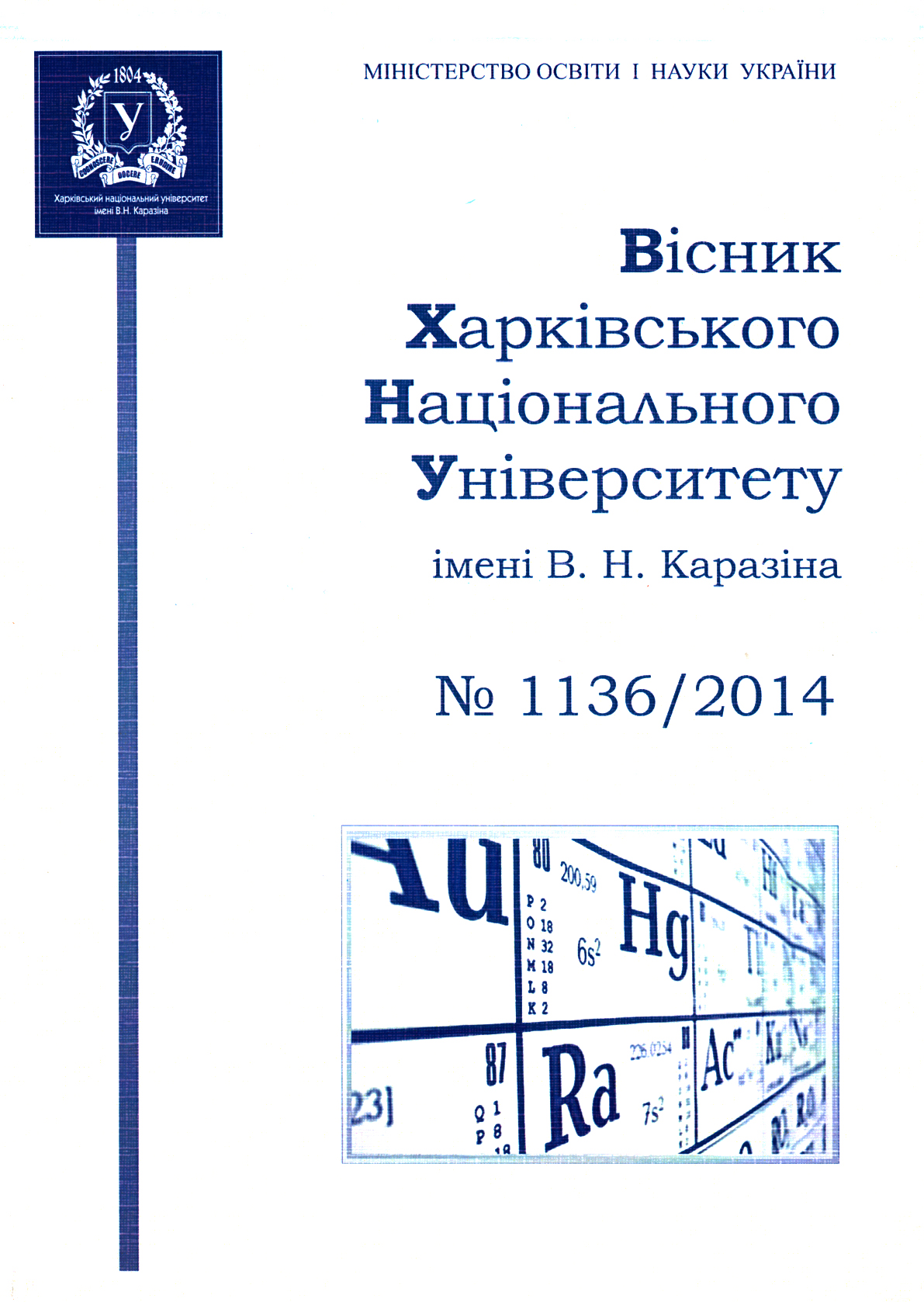Influence of a medium effect on the hydrogen bonds in the ion pair [BMIM][PF6]
Abstract
The detailed quantum chemical investigation of the 1-butyl-3-methylimidazolium hexafluorophosphate [Bmim][PF6] ion pairs in vacuum and the dielectric medium of the ionic liquid has been performed. In the framework of the Bader’s theory “Atoms in molecules” the formation of the weak hydrogen bonds between Fluorine atom of PF6– and Hydrogen atoms of [Bmim+] has been identified. It was established that the most positive Hydrogen atom of imidazolium ring as well as Hydrohgen atoms of the alkyl radicals take part in the formation of the weak hydrogen bonds H∙∙∙F. A transfer of ion pairs [Bmim][PF6] from vacuum into the dielectric medium of the ionic liquid is followed by the formation of bifurcate H-bonds with participation of the most positive Hydrogen atom of the imidazolium ring.
Downloads
References
Hallett, J. P.; Welton, T., Room-Temperature Ionic Liquids: Solvents for Synthesis and Ca-talysis. 2. Chem. Rev. 2011, 111, 3508-3576.
Torimoto, T.; Tsuda, T.; Okazaki, K. I.; Kuwabata, S., New Frontiers in Materials Science Opened by Ionic Liquids. Adv. Mater. 2010, 22, 1196-1221.
Olivier-Bourbigou, H.; Magna, L.; Morvan, D., Ionic liquids and catalysis: recent progress from knowledge to applications. Appl. Catal., A 2010, 373, 1-56.
Giernoth, R., Task-Specific Ionic Liquids. Angew. Chem., Int. Ed. 2010, 49, 2834-2839.
Patel, D. D.; Lee, J.-M., Applications of Ionic Liquids. Chem. Rec. 2012, 12, 329-355.
Endres, F.; Zein El Abedin, S., Air and Water Stable Ionic Liquids in Physical Chemistry. Phys. Chem. Chem. Phys. 2006, 8, 2101-2116.
Wasserscheid, P.; Schröer, W., Towards a better fundamental understanding of ionic liquids. J. Mol. Liq. 2014, 192, 1-2.
Angenendt, K.; Johansson, P., Ionic liquid structures from large density functional theory cal-culations using mindless configurations. J. Phys. Chem. C 2010, 114, 20577-20582.
Tokuda, H.; Tsuzuki, S.; Susan, M. A. B. H.; Hayamizu, K.; Watanabe, M., How ionic are room-temperature ionic liquids? An indicator of the physicochemical properties. J. Phys. Chem. B 2006, 110, 19593-19600.
Avent, A. G.; Chaloner, P. A.; Day, M. P.; Seddon, K. R.; Welton, T., Evidence for hydrogen bonding in solutions of 1-ethyl-3-methylimidazolium halides, and its implications for room-temperature halogenoaluminate(III) ionic liquids. J. Chem. Soc., Dalton Trans. 1994, 3405-3413.
Bonhôte, P.; Dias, A.-P.; Papageorgiou, N.; Kalyanasundaram, K.; Grätzel, M., Hydrophobic, highly conductive ambient-temperature molten salts. Inorg. Chem. 1996, 35, 1168-1178.
Consorti, C. S.; Suarez, P. A. Z.; de Souza, R. F.; Burrow, R. A.; Farrar, D. H.; Lough, A. J.; Loh, W.; da Silva, L. H. M.; Dupont, J., Identification of 1,3-dialkylimidazolium salt su-pramolecular aggregates in solution. J. Phys. Chem. B 2005, 109, 4341-4349.
Rizzuto, A. M.; Pennington, R. L.; Sienerth, K. D., Study of the BMIM-PF6: acetonitrile bi-nary mixture as a solvent for electrochemical studies involving CO2. Electrochim. Acta 2011, 56, 5003-5009.
Trivedi, S.; Sarkar, A.; Pandey, S., Solvatochromic absorbance probe behavior within 1-butyl-3-methylimidazolium hexafluorophosphate + propylene carbonate: preferential solvation or solvent–solvent interaction? Chem. Eng. J. 2009, 147, 36-42.
Chagnes, A.; Diaw, M.; Carré, B.; Willmann, P.; Lemordant, D., Imidazolium-Organic Sol-vent Mixtures as Electrolytes for Lithium Batteries. J. Power Sources 2005, 145, 82-88.
Ziyaei Halimehjani, A. , Shakourian-Fard, M., Farvardin, M.V., Raeesi, M., Hashemi, M.M., Behzadi, H. Design and synthesis of new family of ionic liquids based on 2-iminium-1,3-dithiolanes: A combined theoretical and experimental effort. J. Mol. Struct. 2014, 1056-1057, 56-62.
Zhang, Q.-G., Wang, N.-N., Wang, S.-L., Yu, Z.-W. Hydrogen bonding behaviors of binary systems containing the ionic liquid 1-butyl-3-methylimidazolium trifluoroacetate and wa-ter/methanol. J. Phys. Chem. B 2011, 115, 11127-11136.
Zheng, Y.-Z., Wang, N.-N.ab, Luo, J.-J., Zhou, Y., Yu, Z.-W. Hydrogen-bonding interactions between [BMIM][BF4] and acetonitrile. Phys. Chem. Chem. Phys. 2013, 15, 18055-18064.
Rawat, P., Singh, R.N. Spectral analysis, structural elucidation and evaluation of chemical re-activity of synthesized ethyl-4-[(2-cyano-acetyl)-hydrazonomethyl]-3,5- dimethyl-1H-pyrrole-2-carboxylate through experimental studies and quantum chemical calculations. J. Mol. Struct. 2014, 1074, 201-212.
Lü, R. , Qu, Z.b, Yu, H., Wang, F., Wang, S. The electronic and topological properties of in-teractions between 1-butyl-3-methylimidazolium hexafluorophosphate/ tetrafluoroborate and thiophene. J.Mol. Graph. and Model. 2012, 36, 36-41.
Bader, R. F. W., A quantum theory of molecular structure and its applications. Chem. Rev. 1991, 91, 893-928.
Bader, R. F. W., Atoms in molecules. Acc. Chem. Res. 1985, 18, 9-15.
Weingärtner, H., The Static Dielectric Constant of Ionic Liquids. Z. Phys. Chem. 2006, 220, 1395-1405.
Gaussian 09, Revision B.01. M. J. Frisch, G. W. Trucks, H. B. Schlegel, G. E. Scuseria, M. A. Robb, J. R. Cheeseman, G. Scalmani, V. Barone, B. Mennucci, G. A. Petersson, H. Nakatsuji, M. Caricato, X. Li, H. P. Hratchian, A. F. Izmaylov, J. Bloino, G. Zheng, J. L. Sonnenberg, M. Hada, M. Ehara, K. Toyota, R. Fukuda, J. Hasegawa, M. Ishida, T. Nakajima, Y. Honda, O. Kitao, H. Nakai, T. Vreven, J. A. Montgomery, Jr., J. E. Peralta, F. Ogliaro, M. Bearpark, J. J. Heyd, E. Brothers, K. N. Kudin, V. N. Staroverov, T. Keith, R. Kobayashi, J. Normand, K. Raghavachari, A. Rendell, J. C. Burant, S. S. Iyengar, J. Tomasi, M. Cossi, N. Rega, J. M. Millam, M. Klene, J. E. Knox, J. B. Cross, V. Bakken, C. Adamo, J. Jaramillo, R. Gomperts, R. E. Stratmann, O. Yazyev, A. J. Austin, R. Cammi, C. Pomelli, J. W. Ochterski, R. L. Mar-tin, K. Morokuma, V. G. Zakrzewski, G. A. Voth, P. Salvador, J. J. Dannenberg, S. Dapprich, A. D. Daniels, O. Farkas, J. B. Foresman, J. V. Ortiz, J. Cioslowski, and D. J. Fox, Gaussian, Inc., Wallingford CT, 2010.
Grabowski S.J. What Is the Covalency of Hydrogen Bonding? Chem. Rev. 2011, 111, 2597-2625.
AIMALL: http://aim.tkgristmill.com




